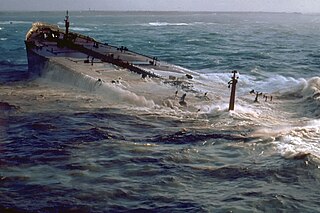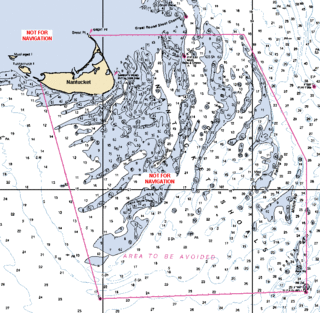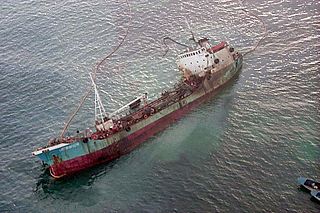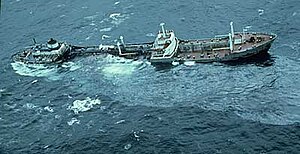
The Exxon Valdez was an oil tanker that gained notoriety after running aground in Prince William Sound, spilling its cargo of crude oil into the sea. On 24 March 1989, while owned by the former Exxon Shipping Company, captained by Joseph Hazelwood and First Mate James Kunkel, and bound for Long Beach, California, the vessel ran aground on the Bligh Reef, resulting in the second largest oil spill in United States history. The size of the spill is estimated to have been 40,900 to 120,000 m3. In 1989, the Exxon Valdez oil spill was listed as the 54th-largest spill in history.

Amoco Cadiz was a VLCC owned by Amoco Transport Corp and transporting crude oil for Shell Oil. Operating under the Liberian flag, she ran aground on 16 March 1978 on Portsall Rocks, 2 km (1.2 mi) from the coast of Brittany, France. Ultimately she split in three and sank, resulting in the largest oil spill of its kind in history to that date.

MVSelendang Ayu, IMO number: 9145528, was a Malaysian-registered Panamax bulk cargo ship chartered by the IMC Group. It ran aground off Unalaska Island in western Alaska's Aleutian Islands on 8 December 2004 after its engine failed. Six crew members died when a rescue helicopter was engulfed by a breaking wave; the ship broke in two, resulting in a large oil spill.

On August 11, 2006, an oil spill occurred in Panay Gulf when the oil tanker, MT Solar 1, sank off the coasts of Guimaras and Negros in the Philippines, causing what is considered to be the worst oil spill in the country's history.

Nantucket Shoals is an area of dangerously shallow water in the Atlantic Ocean that extends from Nantucket Island, Massachusetts, eastward for 23 miles (37 km) and southeastward for 40 miles (64 km); in places water depth can be as shallow as 3 feet (0.91 m). Depth soundings are unpredictable due to the constant change caused by strong currents, which are rotary rather than reversing. The shoals lie just off of a major transatlantic shipping lane. Numerous ships have been wrecked here, most recently and notably the oil tanker Argo Merchant in December 1976. Until 1983, the edge of the shoals was guarded by the Nantucket Lightship.

The Full City Oil Spill was a major fuel oil spill incident that occurred on July 31, 2009 when the bulk carrier Full City ran aground on the island of Såstein / Sastein south of Langesund, Telemark, Norway. The ship, said to be operated by a HK subsidiary of COSCO with 23 crew members on board, spilled around 200 tons, of IFO-380 heavy fuel oil. With also 120 tons of diesel. The oil contaminated 75 km of Norwegian coastline, including Langesund, Vestfold, and the Lille Såstein Bird Sanctuary. There was oil slicks in approximately 200 locations along the shoreline between Larvik Municipality and Lilles.
Katina P was a Greek oil tanker carrying 72,000 tonnes of oil which sank off the Mozambique coast on 26 April 1992.

The 2010 Great Barrier Reef oil spill occurred on 3 April 2010, when the Chinese bulk coal carrier, MV Shen Neng 1 ran aground east of Rockhampton in Central Queensland, Australia. The vessel is owned by Shenzhen Energy Transport Co. Ltd.

MV Jessica was an oil tanker that was involved in an oil spill in the Galápagos Islands, a chain of islands 972 km (525 nmi) west of continental Ecuador, of which they are a part. The ship was registered in Ecuador and owned by Acotramar. On the evening of 16 January 2001, Jessica ran aground at Wreck Bay, at the entrance to the port of Puerto Baquerizo Moreno, the capital of the Galápagos Province, located on the southwestern coast of San Cristóbal Island. The ship was carrying 600 tons of diesel oil and 300 tons of intermediate fuel oil. The diesel was destined for the fuel dispatch station on Baltra Island, while the fuel oil was destined for the tourist vessel Galapagos Explorer.
Odyssey, which previously went by the name Oriental Phoenix, was an oil tanker in operation from 1971 to November 10, 1988, when an explosion caused it to sink in the North Atlantic off the coast of Canada. The resulting spill remains one of the largest oil spills in world history. The tanker was 700 nautical miles off the coast of the Canadian province of Nova Scotia when it sank and released 132,157 tons of oil into the ocean, valued at some $86.7 million (2010). By way of comparison, 4 times as much oil was spilled by the Odyssey as from the much more famous Exxon Valdez.

The Amoco Cadiz oil spill took place on 16 March 1978, when the oil tanker Amoco Cadiz, owned by the American petroleum company Amoco, ran aground on Portsall Rocks, 2 km (1.2 mi) from the coast of Brittany, France. The vessel ultimately split in three and sank. The US National Oceanic and Atmospheric Administration (NOAA) estimates that the total oil spill amounted to 220,880 tonnes of oil which amounts to over 58 million gallons or 256.2 million litres, making it the largest oil spill of its kind at the time.
The SS Wafra oil spill occurred on 27 February 1971, when SS Wafra, an oil tanker, ran aground while under tow near Cape Agulhas, South Africa. Approximately 200,000 barrels of crude oil were leaked into the ocean. The larger part of the ship was refloated, towed out to sea, and then sunk by the South African Air Force to prevent further oil contamination of the coastline.
MVABT Summer was an oil tanker which was built at the South Korean shipbuilding yard of Ulsan and launched in 1974. The vessel was 344 meters in length and almost 54 meters in breadth. While under a Liberian flag, fully laden with Iranian crude and en route to Rotterdam, she sank 700 nautical miles off the Angolan coast. An unexplained explosion occurred on May 28, 1991, and the ship and its cargo began to burn. Five of the crew of thirty-two were killed in the incident, four of whom were initially reported as missing. The following day, a slick 32 kilometres (20 mi) long and 7 kilometres (4.3 mi) wide began to form. The ship continued to burn for three days before sinking on June 1. The vessel's 260,000 tonne cargo of oil was lost, leaving a visible slick on the ocean surface of approximately eighty square miles. Attempts to locate the wreck following the incident proved unsuccessful.

Seaforth Channel is a channel in the Central Coast region of the Canadian province of British Columbia which is part of the Inside Passage - the 950 miles (1,530 km) passage between Seattle, Washington and Juneau, Alaska. The marine highway goes through Seaforth Channel on the way to Milbanke Sound, one of the open sea portions of the Inland Passage. Seaforth Channel which is part of the Prince Rupert/Port Hardy BC ferry route, extends in a westerly direction from Denny Island to Milbanke Sound between Denny Island, Campbell Island and the Wright group of islands on the south. In October 2016, a Texas-owned tug/barge transiting the Canadian waters of the Inside Passage without a local pilot was hard grounded on a reef at the entrance to Seaforth Channel in October 2016. More than 100,000 L of fuel contaminated the coast, coves and shores 20 km (12 mi) west of Bella Bella, the core community of the Heiltsuk Nation as well as the environmentally sensitive Great Bear Rainforest - Canada's contribution to the Queen's Commonwealth Canopy (QCC), a network of forest conservation programs. Clean up response and salvage was criticized by the Heiltsuk, B.C. Premier Christy Clark and Prime Minister Justin Trudeau. In November in Vancouver the Prime Minister announced a $1.5B ocean protection plan to "create a marine safety system, restore marine ecosystems and undertake research into oil spill cleanup methods."
The Sanchioil tanker collision occurred on 6 January 2018 when the Panamanian-flagged, Iranian-owned tanker Sanchi, with a full natural-gas condensate cargo of 136,000 tonnes, sailing from Iran to South Korea, collided with the Hong Kong-flagged cargo ship CF Crystal 160 nautical miles (300 km) off Shanghai, China. Sanchi caught fire shortly after the collision; after burning and drifting for over a week, it sank on 14 January.

The MV Wakashio oil spill occurred after the Japanese-controlled bulk carrier Wakashio ran aground on a coral reef on 25 July 2020 at around 16:00 UTC. The ship began to leak fuel oil in the following weeks, and broke apart in mid August. Although much of the oil on board Wakashio was pumped out before she broke in half, an estimated 1,000 tonnes of oil spilled into the ocean in what was called by some scientists the worst environmental disaster ever in Mauritius. Two weeks after the incident, the Mauritian government declared the incident a national emergency.
The Amazon Venture oil spill occurred at the port of Savannah on the Savannah River in the U.S. state of Georgia. The spill, which occurred from December 4 to 6, 1986, was caused by three defective valves in the piping system of the oil tanker MV Amazon Venture, which leaked approximately 500,000 US gallons of fuel oil into the river.














